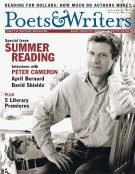Scott Russell Sanders employs the form for self-revelation. "I write essays as a way of making discoveries about my own life, about the world, about my past," he says. "The essay is a seeking of a pattern, meaning, or understanding in an area where I'm bewildered, puzzled, or confused."
Both writers have worked extensively in other forms. And they keep finding themselves returning to the essay for the allowances it makes for them.
Another compelling feature of the essay is that it opens wide the doors of structural possibility. Essays inherently lend themselves to meandering, anecdote, and disclosure. "They're amorphous; they're protean," says Cynthia Ozick. "They have a million forms, and that's part of the wonder and the freedom of the essay."
And therein also lies the essay's struggle for identity, the point at which it threatens to dissolve into so many other things or into nothing at all. Any form, after all, must have shape, no matter how pale its lines or fluid its borders.
Lopate, editor of The Art of the Personal Essay (Anchor Books, 1994), believes that the true essay is never formless. "It follows a track of someone's thoughts," he says. "So it may not have the same form as a short story, and it may not release its epiphanies in the same way as short fiction, but it generally has a rise and fall, and it appears to dig up something, to reach deeper understandings than it began with, and all that's a kind of form."
Atwan sees the essay as having a kind of "intellectual plot." He says, "There's something going on, some dilemma, something at issue."
And the essay is not averse to employing the devices of other forms, says Ozick, who has published novels, short stories, criticism, and essays. "The nonfiction form can give you some of the enchantments of the fiction form, including revelations, moments of suspense, moments of climax, moments of crescendo," she says.
The prolific Joyce Carol Oates, editor of The Best American Essays of the Century (Houghton Mifflin, 2000), agrees that many contemporary essayists are verging on fiction's domain. "The essayist may be embroidering a little, using some of the devices of the fiction writer," she says. "There's a heightening of suspense, a recollection of dialogue and detail."
This, she says, breaks from 19th-century excursions into the form, most notably in the works of Ralph Waldo Emerson and Henry David Thoreau. "The older form is much more rhetorical," Oates says, "and the newer form is much more cinematic."
Yet whatever it might borrow from fiction—or film, for that matter—Lopate says, the essay reverses one fundamental rule of good fiction writing: Show, don't tell. When writing an essay, Lopate says, "It's not enough to render the experience. You also have to put it in perspective. It's not enough to show. You also have to tell."








